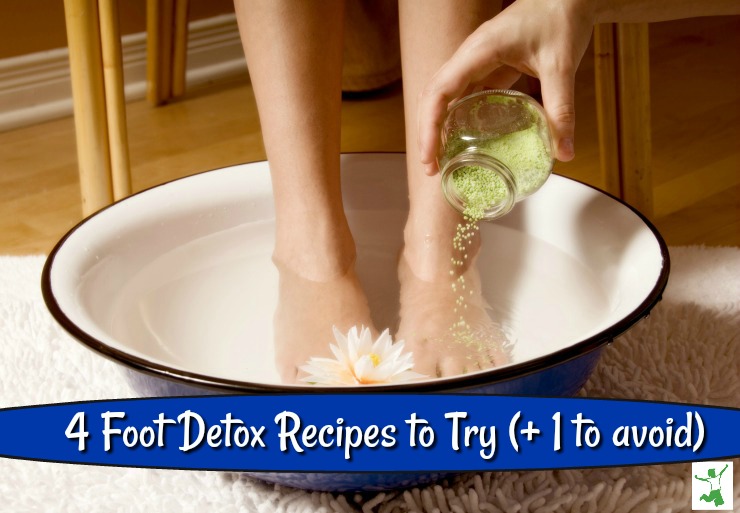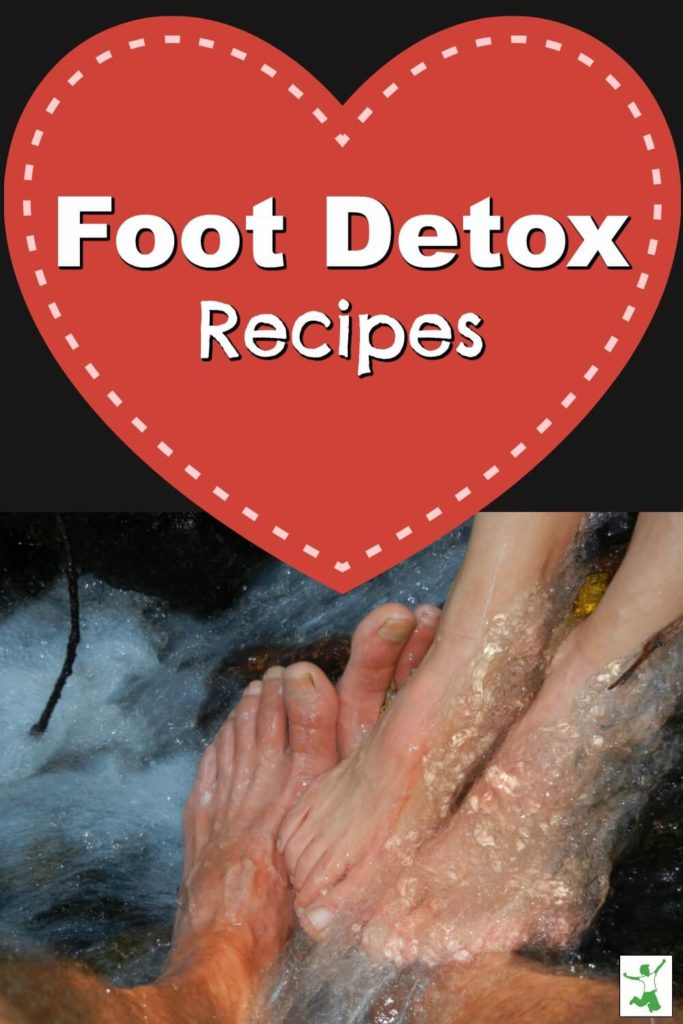The benefits of a foot detox with recipes to try should a full-body bath not be convenient or possible due to health conditions or living circumstances.

Many health-conscious people realize that gentle cleansing baths are a necessary undertaking in our polluted world. From the many emails I receive on the subject, however, a basic bathtub is surprisingly not available in some living complexes. In those situations, a foot detox is absolutely the next best thing!
A relaxing foot soak is also a good way to destress while watching a movie or reading a book in the living room. It is also preferable to a full body bath if you live in a warm climate and the thought of a hot detox bath is not appealing. I can relate! No detox baths for me during June, July, and August!
Seniors sometimes prefer foot detoxing with a small portable tub given the risk of slipping and falling getting in and out of a porcelain or steel bathtub.
If the idea of a foot soak is something you would like to try, below are some health-boosting recipes for you to consider. Depending on your physical condition and health status, one particular foot detox recipe may prove preferable to another.
Foot Baths to Try (and Ones to Avoid)
Before we get started on the how-to, let’s discuss the what.
Detox foot bathing is best accomplished when the soak itself won’t contribute additional toxins to the process. In other words, it is best to avoid the use of a plastic foot tub if at all possible. Adding hot water and ingredients like vinegar have the potential to leech chemicals into the water. This would be counterproductive to the cleansing process.
If detoxing the feet is something you will be doing often, it is probably best to invest in a wooden mini tub or large porcelain bowl.
A galvanized bucket is a budget-friendly, nontoxic option as well. This lightweight foot basin is a more economical option.
While a plastic foot spa works fine for alkaline soaks, avoid using it for foot detoxes that use vinegar.
Best Foot Detox Recipes
Below are several recommended foot detox mixtures to try.
In addition, one type of foot soak is discouraged along with a commercial product that is a scam.
Epsom Salt Foot Soak for Injuries
A soak in Epsom salt is probably the most popular way to soothe and detox the feet.
If there are any bruises or an injury like a sprain or plantar fasciitis present, dissolve 2 cups of Epsom salt into a gallon warm to hot water. A water temperature of about 100-102 °F/ 38-39 °C is ideal. Add additional hot water to fill the foot tub and soak for 20-40 minutes.
An Epsom salt foot detox is not appropriate if there are any open ulcers or wounds present on the skin.
It is not a good idea to add vinegar to the water in the foot tub as the acidity of the vinegar competes with the alkalizing effect of the Epsom salt. This renders the foot detox less effective. Feel free to add a few drops of essential oils if you desire instead.
I prefer Epsom salt to magnesium flakes as Epsom salt contains both magnesium and sulfur. Many people are deficient in both of these critical minerals. Sulfur, in particular, is important for effective detoxification. Magnesium flakes, on the other hand, contain magnesium and chloride. They also tend to be significantly more expensive.
Note: Epsom salt from Walmart is just as good as brands from the health food store. See the linked article for more info on how to procure magnesium sulfate crystals for less without sacrificing quality!
All-Purpose Vinegar Soak
A vinegar soak is very helpful for an all-purpose foot detoxification effect. I prefer raw apple cider vinegar (ACV) packed in glass for this purpose (sources). This is because vinegar packed in plastic will leech toxins into the vinegar. These toxins will end up in your detoxing foot bath.
In addition, GMO corn is the typical crop used to make conventional white vinegar, so beware!
If the price of quality apple cider vinegar deters you, try making ACV yourself. Note that some brands of ACV packed in glass are pasteurized and not raw. Read the label carefully to know what you are buying!
Wine vinegar can be used for foot soaks but tend to have an overly strong smell in my experience.
To do a vinegar foot soak, add 1 cup of ACV to a foot tub filled with warm to hot water and soak for 20 minutes. Again, a water temperature of about 100-102 °F/ 38-39 °C works well. Step out onto a towel and gently dry feet without rinsing. The ph balancing effect of the vinegar on the skin serves as a deodorant that helps keep tootsies sweet-smelling.
I don’t suggest adding essential oils to a vinegar detox. Doing so may interfere with the pH balancing effect of the vinegar on the skin of the feet.
Baking Soda and Sea Salt
Baking soda and sea salt make a great combination for an effective foot detox. To make, dissolve 1 cup of bath sea salt and 1 cup of baking soda (any brand will do) in water as hot as you can stand in a foot bath.
Keep your feet in the foot tub for about 45 minutes until the water has cooled down. If the foot bath is too hot, you can add some cold water if this is the only way you can manage to stay in for at least 30 minutes. Don’t add more hot water after beginning the foot soak, however.
Do not rinse the feet but simply pat them dry with a towel when the detox is complete. This foot bath may leave you very tired so do it before a nap or in the evening before bed if possible.
According to Dr. Hazel Parcells, this bath recipe is therapeutic for any exposure to environmental radiation, x-rays, plane flights or airport screenings by TSA. (1)
Antifungal Foot Soak
If a fungal infection of the feet is a problem with symptoms of itchiness, scaling or peeling, then an antifungal foot detox is the best way to go.
Using small amounts of boric acid or plain borax powder dissolved in warm water, this home remedy works fast for Athlete’s foot in particular.
Symptoms resolve in about a week versus a month for over-the-counter antifungal creams.
Skip the Listerine Foot Bath
Some sources say that a 10-minute foot soak in 1/4 cup of Listerine mouthwash, 1/4 cup of white vinegar, and 1/2 cup of warm water will leave your feet soft and free of dead skin. While the experience will definitely tingle your tootsies, it won’t really remove dead skin as promised. An organic pedicure will do the job much better!
As for detoxing, given all the chemicals in Listerine including the preservatives benzoic acid, sodium benzoate, and carcinogenic caramel coloring, don’t count on the process helping to cleanse much of anything.
If you desire the antiseptic nature of Listerine to help with infections on the feet or ankles, then simply do a hydrogen peroxide soak instead. Add a cup of 3% food grade H2O2 to the warm water in the foot bath and soak for 20 minutes for a chemical-free experience!
Avoid Foot Detox Pads!
If you are tempted to use the convenient and rather expensive detox foot pads that are available at health food stores and online, don’t bother.
Research indicates that not only do they not work, but they may also be contaminated with heavy metals and other toxins.









You may want to look into tea tree oil for killing foot fungus. I read about this awhile back. I believe I found it through Pintrest. I gave the recipie to a friend and she said it worked but you have to use it continuously and it takes awhile for it to kill the fungus but once it does, if you stop using it the fungus will come right back.
The past 10years I am allergic to everything is there a foot soak that would help
What are your recommendations for during pregnancy? Is a foot detox safe?
A friend of mine swore by a coffee foot bath. She just poured leftover coffee into the basin with warm water. Not only ‘detoxing’ but she said it always made her sleep like a baby. I haven’t tried it, but thought other might like to.
Is there a good method to get rid of toenail fungus? I’ve had it for years now and am not sure what to try.
Toenail fungus is very hard to get rid of once you have it (it is caused by antibiotics and an imbalanced gut and skin environment). You can try covering the nail with petroleum jelly and keeping it thoroughly covered for a number of weeks which can kill the fungus eventually.
What ratios would you use if taking a whole body bath? Are these safe for children as well?
This article contains the amounts for full baths: https://www.thehealthyhomeeconomist.com/detox-baths-which-ones-are-best-and-for-what-ailments/
Consult with your practitioner about detox baths for children.
What about the footbaths you can buy at places like Bed, Bath, and Beyond? I’m curious to see if those work well, or if they don’t produce the “detox” that we’re looking at here.
Those popular foot spas are made of hard plastic .. at least the ones I’ve looked at. They seem to be more for foot relaxation instead of detoxing.
Sarah, what is it about the feet that make it capable of detoxing your whole body? Ive always heard this, but I would love to understand the physiology/anatomy!
The circulating of the blood though the feet while you are soaking them in the foot bath is what allows toxins circulating anywhere in the body to be exposed to the cleansing effect. For example, one bloodcell can circulate the entire body in about 1 minute. A whole body detox bath is best as it exposes a lot more skin to the process, but the feet are certainly a good starting point and you can get a good detox effect just soaking them alone.
Sarah,
Where can one buy the blue porcelain bowl featured in the photo? It’s a nice
size and color….
Bianca, The bowl appears to be an enamel covered steel bowl, and you can do a quick web search for one. I came up with a similar one on Amazon.com.
Will you please tell us how often these foot detoxins should be done, safely?
A few times a week works great.